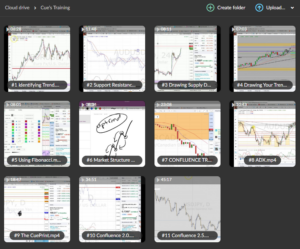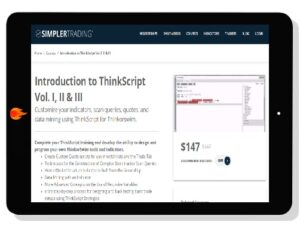AlgoTrading – AlgoTrading101 Courses
AlgoTrading – AlgoTrading101 Courses course is now available at an affordable price. You can check out directly using multiple payment gateway options. If you have any questions or need an alternative payment method, feel free to contact us.
Description
In the dynamic trading realm, the edge goes to those who constantly evolve, learn and adapt. AlgoTrading101 is meticulously designed to provide traders with that edge.
Whether you’re just setting sail in the trading world or looking to sharpen your existing skills, this course offers a structured path to mastering the art and science of algorithmic trading. Don’t just trade; trade bright with AlgoTrading101.
AlgoTrading101 delivers a comprehensive, step-by-step foray into the intricate world of algorithmic trading. The course, streamlined for both beginners and intermediate traders, is partitioned into two main segments:
AT101: Algorithmic Trading Immersive Course
PT101: Practical Quantitative Trading with Python Masterclass
What You’ll Learn In AlgoTrading101 Courses
AT101: A Deep Dive into Algorithmic Trading
AT101 demystifies the foundational pillars of trading strategy – from its conceptualization, testing, and final execution. Here’s a sneak peek into the expansive curriculum:
The Algo Trading Primer: Grasp the mechanics behind Algo Trading Robots, explore Forex markets, and dabble with your first robot – Adeline!
Beyond Basics: Delve into strategy development, uncover the secrets of data management, and challenge yourself with hands-on coding exercises.
Advanced Strategies: Meet Belinda and Clarissa, robots that teach you the nuances of volatility and time-based trading.
Robust Trading Foundations: Arm yourself with advanced position sizing techniques, backtesting insights, and knowledge of the essential statistics to ensure you’re always one step ahead in the trading game.
The Finishing Touches: Enhance your trading strategies with Advanced Order Management, immerse yourself in coding best practices, and understand the art and science of algorithmic trading with real money.
PT101: Quantitative Trading, Supercharged with Python
While AT101 establishes the groundwork, PT101 propels you into the cutting-edge strategies and techniques employed by today’s trading elite:
Python for Traders: Kickstart with just enough Python to spark your journey. Design a rudimentary pair trading strategy to gauge the course’s tempo.
The Mean Reversion Magic: Dive into concepts like synthetic assets, bond futures, and statistical arbitrage.
Harness the Power of Data: Learn to mine web data using APIs and employ alternative data to sculpt unparalleled trading strategies.
The Correlation Game: Decipher the statistical methodologies behind correlations and leverage them for proactive trading.
Machine Learning Meets Trading: Venture into sentiment and text analysis. Use machine learning to extract actionable insights from vast swathes of news articles.
We don’t give you “sure-win” black boxes.
We teach you the methods to craft effective strategies.
Code Your First Robot in Three Days
Afraid of coding? Most of our members code their first (simple) robot within three days.
No prior trading or coding experience required.
If you’re still stuck, we’ll be here to drag you out of the coding rut.
Master The 6 Major Skill Sets You Need As An Algorithmic Trader
Trading Robot Design
Use market logic and statistical methods to build effective trading robots. Know why your robots work or break down.
Market Theories
Interpret and understand market behavior. No prior finance or trading knowledge required for our programme.
Coding
Learn the coding skills required from scratch. No prior coding experience required. We use Python, MQL4, MQL5 and VBA.
Data Handling
Garbage in = garbage out. Inaccurate data leads to inaccurate results. Learn appropriate data management skills to ensure accurate testing.
Risk Management
We look at market and operational risk. Maximise upsides while minimising downsides. Prevent system crashes, downtime and theft by hackers.
Live Execution
Backtesting and live trading are very different. Select proper brokers, infrastructures and evaluation procedures to manage your robot throughout its lifetime.
About Courses:
AlgoTrading101 Course Syllabus
AlgoTrading101 consists of 2 main courses:
AT101: Algorithmic Trading Immersive Course
PT101: Practical Quantitative Trading with Python Masterclass
AT101 focuses on the fundamentals of trading strategy design, testing and execution.
PT101 focuses on modern and more advanced strategies such as:
Obscure markets like Canadian bond STIR futures
Multi-asset strategies
Alternative data
Web scraping
Machine learning
AT101: Algorithmic Trading Immersive Course
Chapter list (along with learning objectives for each chapter)
AT101: Algorithmic Trading Immersive Course
Chapter list (along with learning objectives for each chapter)
Here’s What You Are In For!
What is an Algo Trading Robot, its key traits and code structure
What makes a successful Algo Trader
How to set up and navigate your infrastructure/coding software
Programming Basics 1: Variables and Conditional
Basics of our coding language (MQL4)
Syntax, Variables, Operations and Conditional Expressions
Robot 1: Adeline – Our First Robot!
Background to Forex markets, chart reading, basic indicators
Coding Adeline together
Testing Adeline using past data
Brief look at modelling quality
Uncommon Common Sense. Design Effective And Logical Robots
Overview of our Strategy Development Guide
Preliminary Research
Backtesting
Optimisation
Live Execution
Pros and Cons of an Algo Trading Robot
Mathematical Expectations of our robots’ performance
Garbage In, Garbage Out. Understanding Data
Data Sources and Storage
A look at the importance of data cleanliness
Cleaning data (basic)
Bad ticks, inaccurate testing and market tricksters
Programming Basics 2: Loops
Learning how to code loops
Practice Exercises for Loops
Robot 2: Belinda – Utilising Volatility!
Our first measure of volatility (ATR)
Introducing Belinda, the improved version of Adeline
Coding and testing Belinda
To Buy Big or Small? Position Sizing and Money Management
Understanding trade/bet size (how much to trade per position) using a coin flip game
Designing a bet sizing algorithm based on account size
Coding our bet sizing algorithm
Robot 2A: Belinda Upgraded (No Gambler’s Ruin for Me!)
Implementing our bet sizing algorithm in Belinda
Where To Start? Idea Generation and Expectations
Setting expectations for our robots based on our resources, personality, skill set, lifestyle and goals
Understand the essence of a trading idea – Proxies and Relationships
Sources of trading ideas
A look at the different types of strategies
Grading ideas – Introducing our framework for vetting ideas
How to fight against big hedge funds
Programming Basics 3: Functions, Time and Self-Learning
Learn to learn programming
Code errors and debugging
Coding Functions
Practice Exercises for Functions
Relevant Statistics 101!
Statistical significance and Law of Large numbers and their role in robot testing
Deriving suitable minimum sample size for our backtests
Understanding Robot Behaviour and Robustness: Backtesting!
Ensuring code accuracy
Types of market condition
Testing for Robustness
Period Robustness
Timeframe Robustness
Seasonal Robustness
Instrument Robustness
Testing our robots through intended and unintended periods
Stress testing our robots through black swans
The butterfly Effect – Backtest bias via start point selection
Grading the performance of our robots
Programming Basics 4: Arrays And Indicators
A look at our mentality towards Indicators
Math behind Indicators
Coding Arrays and Indicators
Robot 3: Clarissa – Playing with Time
Understanding the Datetime data type
Coding rules revolving date and time manipulation
Introducing and coding Clarissa – our robot that uses time entries
What A Mess – Managing Trades, Orders and Positions
Order limitations by your brokers
Coding our customised order function
Multiple order management
Modelling transaction cost, spreads and slippage
Robot 4: Desiree – Trade like the Turtles
The history of the Turtle Traders
Introducing and coding a simplified turtle strategy
Design Theories I – Improving Robots By Manipulating Time, Entries and Exits
Profitability in different timeframes
Deriving optimal stop loss levels
Comparing the importance of entries vs exits
Analysing asymmetrical long and short rules
Add A Twist To Your Orders – Advanced Order Management
Breakeven and trailing stops
Hiding from your broker – Creating virtual stops and take profit orders
Robot 5: Desiree 2.0
Buff Up Your Robot Responsibly – Optimisation Without Curve Fitting
Objective Functions, Robustness and Curve Fitting
10 Ways to minimise curve fitting (overfitting)
Degrees of Freedom
Parameter Robustness
In and out-of-sample testing
Optimisation Evaluation
Perfect Your Bet Sizing – Advanced Position Sizing Methods
Relationship between sizing and trading frequency
Gearing up and down with volatility
Impossible Trinity of Sizing – Relationship between Leverage, % Risked and Stop Loss
First Principles of sizing – Building customised sizing algorithms
Other types of sizing – Kelly Criterion, Martingales and Anti-Martingales
Robot 6: Elizabeth
Programming Basics 5: Clean Up Your Codes! Simple Is Fast!
Clean and robust coding
MT4 Global Variables
MQL4 Libraries
Garbage In, Garbage Out Again. Advanced Data Cleaning (Part 1)
Creating custom timeframes
Clean data, biased output
Excel VBA – Using Excel Magic to Improve our Trading
Excel trading game
Syntax
Conditional statements
Loops
Garbage In, Garbage Out Again. Advanced Data Cleaning (Part 2)
Data time zone manipulation
Defining “clean enough” data
Scanning for errors
Advanced data cleaning methodologies
I Like Colors And Shapes – Adding Graphics
Creating a Dashboard: Graphics and Labels
Creating trendlines and levels
Ring Ring! Notify Yourself When Something Goes Wrong (Or Right)
Coding smartphone notifications
Notify yourself during trade or price events
Robot 7: Faye – Semi-Automated Trading
Connect with the outside world – Importing and Exporting Data out of our Trading Platform
Read and write information to Excel
Build a spread logger
Programming Basics 6: Trading Platform Nuances
Perfecting the little coding details
Understanding trading and backtesting nuances
Design Theories II – The “Secret Sauce”
Prudence-Behavioural Framework
Alpha 1: Data
Alpha 2: Global Macro
Alpha 3: High-Frequency Trading
Alpha 4: Market Microstructure
Hybrid Model – Semi-Algorithmic Trading
5 Realities of Algorithmic Trading
Crowd Behaviour – Outwitting the Masses
Walking Forward – Advanced Optimisation
Walk Forward Optimisation
Performance patterns, consistency and seasonality
3D Parameter space evaluation
Trading CFDs
Looking Outwards – Trading On External Info and Alternative Data
Trading using volume
Feeding external data into MT4
Trade on external events
Robot 8: Gwen
Cash Is King! – Running Robots With Real Money
Paper versus Live trading
Minimum Capital Determination
Broker Selection
Virtual Private Servers
Downtime Prevention Protocol
Hedging issues
Strategy Monitor – Updating our robots regularly
Live walk-forward optimisation
Investor Marketplace
Watch Her Well – Monitoring Your Robot(s)
Operational Risk Management
Monitoring our robots
When to manually intervene
Reviewing performance
Understanding Trading Psychology – Emotions during drawdowns
PT101: Practical Quantitative Trading with Python Masterclass
(In progress, we are still adding content)
Practical Strategies for Modern Markets
Basic Python and Test Strategies
Just enough Python to get you started (we will learn more advanced Python techniques in the later part of the course)
Designing a simple pair trading test strategy to whet your appetite and give you an rough sense of what to expect
Cointegration (Mean reversion: When A and B moves apart, we bet they will revert) (WE ARE HERE NOW)
(Concept) Synthetic assets (ranging assets that are made by combining different assets)
(Strategy) Bond futures calendar spreads and structures (creating ranging assets using bond futures)
(Strategy) Market making using a proxy asset (entering and exit trades at the bid and ask prices)
(Strategy) Statistical Arbitrage. Trading hundreds of stocks in a mean reversion manner.
Sentiment Analysis and Web API (Collect data from websites via special “links”)
(Concept) Use Web API to collect data (eg. Google trends to analyse search traffic)
(Strategy) Scour tons of stocks to see which stocks have sudden increase in search traffic volume
Alternative Data (Non-price data like Credit card, Location data etc)
(Strategy) Use paid alternative data from vendors to analyse stocks
(Strategy) Create your own special index by combining different alternative data (eg. combine retail receipts + foot traffic + search traffic to create a special index to predict retail stock prices. Live eg: MongoDB tracker, Crypto Tracker)
(Strategy) Creatively find data on websites and scrape them to predict market moves
Correlation (If A moves, trade B)
(Concept) Understand the statistical methods to test correlations
(Strategy) Use Google search data, job listings and other scrapped data to predict stock and spread movements
(Strategy) Use synthetic assets to predict other synthetic assets
Sentiment and Text analysis (Machine Learning)
(Concept) Evaluate the sentiment of a particular phrase, sentence, paragraph or article
(Strategy) Analyse tons of news articles in different language to find out the market sentiment towards an asset
Related
Delivery Policy
When will I receive my course?
You will receive a link to download/view your course immediately or within 1 to 24 hrs. It may takes few minutes, also few hours but never more than 24 hrs. Due to different time zone reasons.
How is my course delivered?
We share courses through Google Drive, so once your order is complete, you’ll receive an email with a google drive folder access link to view the course in your email.
To avoid any delay in delivery, please provide a Google mail and enter your email address correctly in the Checkout Page.
In case you submit a wrong email address, please contact us to resend the course to the correct email.
Where can I find my course?
Once your order is complete, a link to download/view the course will be sent to your email.







